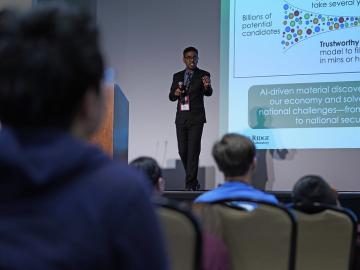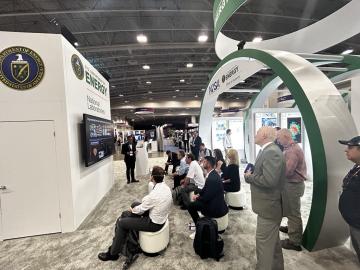
Filter News
Area of Research
- Advanced Manufacturing (1)
- Biological Systems (1)
- Biology and Environment (38)
- Clean Energy (21)
- Computational Biology (1)
- Computer Science (2)
- Electricity and Smart Grid (1)
- Functional Materials for Energy (1)
- Fusion and Fission (7)
- Materials (32)
- Materials for Computing (1)
- National Security (15)
- Neutron Science (10)
- Nuclear Science and Technology (7)
- Quantum information Science (1)
- Supercomputing (44)
News Type
News Topics
- (-) Advanced Reactors (13)
- (-) Artificial Intelligence (56)
- (-) Bioenergy (57)
- (-) Frontier (28)
- (-) Machine Learning (24)
- (-) Molten Salt (2)
- (-) Physics (35)
- 3-D Printing/Advanced Manufacturing (59)
- Big Data (31)
- Biology (66)
- Biomedical (33)
- Biotechnology (11)
- Buildings (24)
- Chemical Sciences (36)
- Clean Water (14)
- Climate Change (57)
- Composites (12)
- Computer Science (103)
- Coronavirus (21)
- Critical Materials (5)
- Cybersecurity (20)
- Decarbonization (49)
- Education (1)
- Emergency (2)
- Energy Storage (44)
- Environment (118)
- Exascale Computing (29)
- Fossil Energy (4)
- Fusion (39)
- Grid (28)
- High-Performance Computing (56)
- Hydropower (5)
- Irradiation (1)
- Isotopes (35)
- ITER (3)
- Materials (74)
- Materials Science (66)
- Mathematics (7)
- Mercury (7)
- Microelectronics (2)
- Microscopy (28)
- Nanotechnology (28)
- National Security (46)
- Net Zero (9)
- Neutron Science (59)
- Nuclear Energy (68)
- Partnerships (23)
- Polymers (13)
- Quantum Computing (23)
- Quantum Science (34)
- Renewable Energy (1)
- Security (14)
- Simulation (36)
- Software (1)
- Space Exploration (13)
- Statistics (1)
- Summit (33)
- Sustainable Energy (55)
- Transformational Challenge Reactor (4)
- Transportation (37)
Media Contacts

The world’s fastest supercomputer helped researchers simulate synthesizing a material harder and tougher than a diamond — or any other substance on Earth. The study used Frontier to predict the likeliest strategy to synthesize such a material, thought to exist so far only within the interiors of giant exoplanets, or planets beyond our solar system.

Two ORNL teams recently completed Cohort 18 of Energy I-Corps, an immersive two-month training program where the scientists define their technology’s value propositions, conduct stakeholder discovery interviews and develop viable market pathways.

Researchers at the Department of Energy’s Oak Ridge National Laboratory and partner institutions have launched a project to develop an innovative suite of tools that will employ machine learning algorithms for more effective cybersecurity analysis of the U.S. power grid.

Researchers conduct largest, most accurate molecular dynamics simulations to date of two million correlated electrons using Frontier, the world’s fastest supercomputer. The simulation, which exceed an exaflop using full double precision, is 1,000 times greater in size and speed than any quantum chemistry simulation of it's kind.

Researchers used quantum simulations to obtain new insights into the nature of neutrinos — the mysterious subatomic particles that abound throughout the universe — and their role in the deaths of massive stars.

In May, the Department of Energy’s Oak Ridge and Brookhaven national laboratories co-hosted the 15th annual International Particle Accelerator Conference, or IPAC, at the Music City Center in Nashville, Tennessee.

Prasanna Balaprakash, a national leader in artificial intelligence, or AI, spoke to some of the highest achieving students in the country at the National Science Bowl in Washington D.C.

When Oak Ridge National Laboratory's science mission takes staff off-campus, the lab’s safety principles follow. That’s true even in the high mountain passes of Washington and Oregon, where ORNL scientists are tracking a tree species — and where wildfires have become more frequent and widespread.

ORNL researchers and communications specialists took part in the inaugural AI Expo for National Competitiveness in Washington D.C, May 7 and 8, to showcase and provide insight into how the lab is leading the way for utilizing the vast possibilities of AI.

Erin Webb, lead for the Bioresources Science and Engineering group at Oak Ridge National Laboratory, has been elected a Fellow of the American Society of Agricultural and Biological Engineers — the society’s highest honor.


